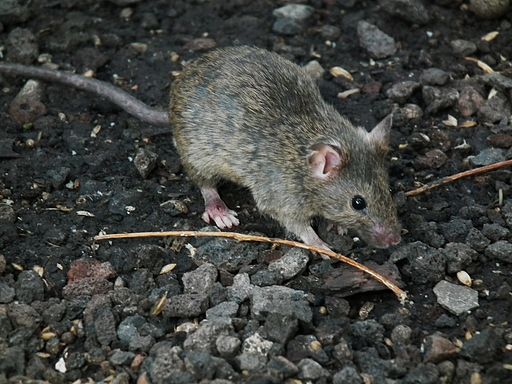SERVICE REQUEST?
Fill out the form below.
Find our nearest location
Your Local Office

House Mouse
Attribution: 4028mdk09, [CC-BY-SA-3.0], via Wikimedia Commons
Size:
Small, its body rarely exceeding two inches long and one ounce in weight.
Color:
Usually gray in color, but some may appear darker.
Behavior:
Few people really like rats or mice, and no one wants them in their house. Rodents live everywhere outside and could enter at any time, but fortunately, this does not occur often. Usually, most home invasions occur in the fall, not because of cooler weather, but because the seeds and plants on which rodents feed outside are gone. Rats and mice must then seek new food sources. Unfortunately, one of these sources may be your home. Mice are excellent climbers and are capable of gaining entry through holes around soffit vents and around cables entering the building, through holes in gable vent screens, and through turbine and box vents on roofs. Most garage doors on homes allow enough space for mice to fit underneath, as well.
Mice are found in almost every part of the country from urban to rural areas, and are especially prevalent in urban and suburban communities. Mice are found in buildings more often than rats because they are smaller and are able to find more available entryways into a building. Mice can fit through a crack or hole 1/4 of an inch or larger – or about the width of a pencil. Mice will make their nests in many areas in and around the home, especially in stacked firewood, stones and bricks, and piles of leaves or other debris.
The best way to avoid invasions of mice is to (1) provide as little harborage as possible that might attract rodents, and (2) seal as many holes and cracks in the outside of the home through which mice might enter. Follow these recommendations to help prevent rodents from seeking the shelter provided by your home:
- Keep firewood stored as far from the home as possible and store it off the ground. During the winter, store only enough wood next to the house to burn every couple of days.
- If possible, remove any piles of debris, stones, bricks, etc. If these are near the foundation of the home they serve as harborages to attract rodents. Once there, it is any easy step for rodents to enter the building itself.
- Do not allow piles of leaves to accumulate next to the home’s foundation. This also serves as attractive harborage for rodents – mice in particular.
- Seal any hole or crack larger than 1/4 of an inch. A good rule of thumb is that if a pencil can fit into it, a mouse could too.
- Large holes or cracks should be stuffed with steel wool or wire mesh before sealing with caulk or foam, otherwise rodents could chew through to enter.
- Install good, thick weather-stripping on the bottom of all doors to prevent rodents from entering. The garage door may prove difficult to seal completely, so the door from the garage to the house must be sealed tightly.
- The installation of one or two wind-up mousetraps in the garage can catch many mice as they enter. These traps can catch up to 15 mice with one setting. Ask your Terminix service professional for more information.
- Remember, your Terminix service includes coverage of commensal rats and mice, and much of the service provided during the colder months is to inspect for signs of rodents and to maintain preventive control measures.
Family Name:
Mus domesticus
Read What Our Clients
Are Saying
My Terminix tech Scott is the best! He is professional, courteous and absolutely thorough about his job. Thank you for sending such a blessed tech to my house. Hamlet, NC
This letter is to say how pleased we are here at Morreene West Apartments with your services. We are very pleased with the technician, Christopher. He does a great job. Durham, NC
Terminix has consistently offered our apartment complex reliable, competent service. We are completely satisfied with their knowledgeable representative who is always punctual and does a superior job for us every time. Chapel Hill, NC
I would like to take the time to thank you for giving us such great service here at Carver Pond Apartments. Your Pest Technician Christopher Mitchell has provided us with excellent service over the last few months. Christopher is such a great help to us in providing helpful information so that we can better serve our residents here at Carver Pond. Durham, NC
SERVICE REQUEST?
Fill out the form below.